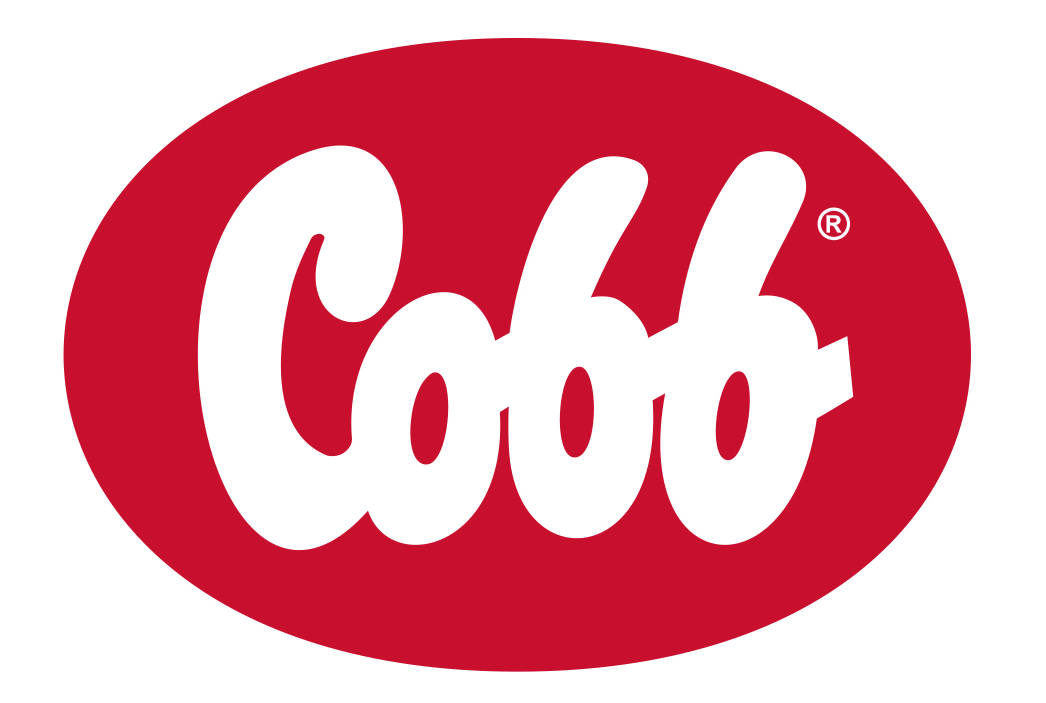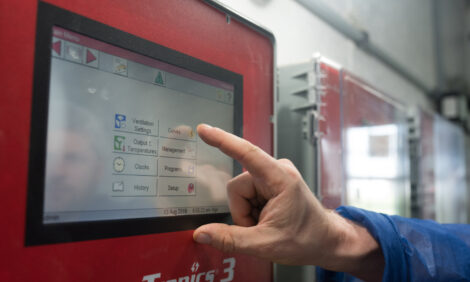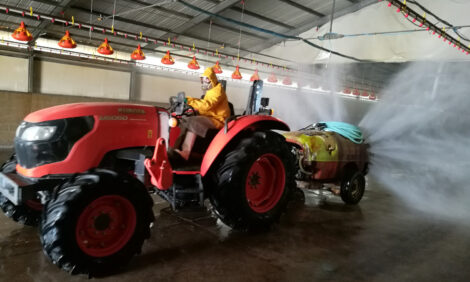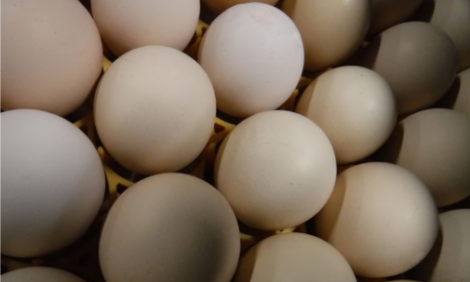



Cobb Breeder Management Guide: Bodyweight control, weighing & analysis
Learn more about hand and automatic weighingPart of Series:
< Previous Article in Series Next Article in Series >
Editor's note: This article is an excerpt from the Cobb Breeder Management Guide and additional articles will follow. The Guide was designed to highlight critical factors that are most likely to influence flock performance. The management recommendations discussed were developed specifically for Cobb products. The recommendations are intended as a reference and supplement to your own flock management skills so that you can apply your knowledge and judgement to obtain consistently good results with the Cobb family of products. To read or download the complete Guide or to view Cobb's other management guides, click here.
There are two recommended ways to feed a flock in rearing and ensure that the birds are in condition at 20 weeks of age.
- Feed according to the Cobb bodyweight profile that is specific for the breed. Be aware that a feed change takes 2 to 3 weeks to be detected in bodyweight change. Therefore, frequent increases and decreases in feed change can be confusing and result in fluctuating bodyweights which can induce stress and affect flock uniformity.
- Feed according to a pre-determined and proven feeding regime with specific feed specifications. The birds are fed based on a program and the birds’ bodyweights are kept between 98 and 102 % of the standard. If the bodyweight deviates too much from the standard the feed amounts should be adjusted up or down in small increments ranging from 1 to 3 g (0.22 to 0.66 lb/100 birds). Again, be aware that feed change takes 2 to 3 weeks to be realized in feed restricted birds.
The two described feeding methods may be used together. Initially, follow the first concept in which the feed amount is determined by the bodyweight development in rearing. Once a good feeding profile is determined, the second concept can be used making it easier on management in general. Using both methods will give more consistent results and success in meeting production targets.
The objective of bodyweight control is to rear all the birds to the target weight for age with good uniformity. Bodyweight targets are achieved by controlling feed allowances. Feed amounts during rearing are based on bodyweight gain and maintenance, whereas in lay they are based on these two factors including egg production and egg weight. Accurate feed amounts can only be determined if the bodyweight is measured accurately every week.
Hand Weighing
The scales used to measure bodyweight must have a maximum capacity of 5 kg (11.02 lb) and be accurate to +/- 20 g (0.05 lb). Scales must be calibrated on a regular basis. It is advantageous to use electronic scales with a printout capability. This will reduce human error and assist the weighing team. At 3 weeks and older, weigh 3 % of the females and 10 % of the males or 50 birds as a minimum representative sample. To increase accuracy of the sampling, use a catching pen, do not randomly pick up and weigh birds. Place catching frames at set locations across the barn – front, middle and back. Weekly sample weights must be representative of the whole house. Do not place a catch frame near the main hopper area because birds in this area tend to weigh above average from eating feed from the hopper.
Forcing birds into the pen or selectively catching birds and placing them in a pen can result in a non-representative flock sample for weighing. Instead, the catch frame should be placed to allow the birds to freely enter the pen for a more representative sample of the flock. Weigh every bird individually inside the catch pen, including small birds, and do not reject any weights, except for sexing errors. After each bird is weighed, release the bird into the house. Continue weighing until the pen is empty.
Record each weight and calculate the average weight as well as the flock weight distribution. Plot the average bodyweight on the appropriate chart and use this data to calculate the feed amount for the following days. It is also important to determine if the feeding program is working and keeping the birds close to the standard bodyweight.
Automatic Weighing
Automatic scales are becoming more popular with improved weighing equipment and software. They can be used daily and over a specific time period each day. Typically, measurements are taken for 1 to 2 hour(s) prior to feeding. As an example: if the lights turn on at 7 AM, then scales operate from 7 to 8 AM or 9 AM with feeding starting at either 8:01 or 9:01 AM.

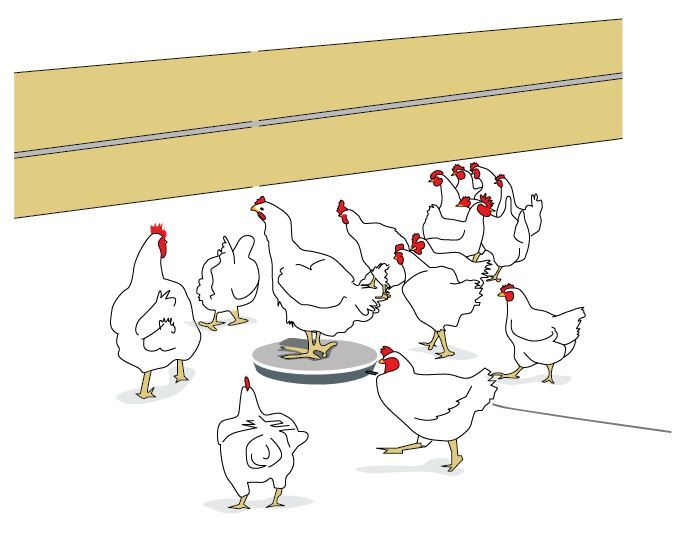
On average, 100 females will step on the scale per hour. The automatic scales are either a suspended or fixed platform, but there is no clear advantage for either. The scale range is normally set between +/- 25 to 30 % of the population mean bodyweight.
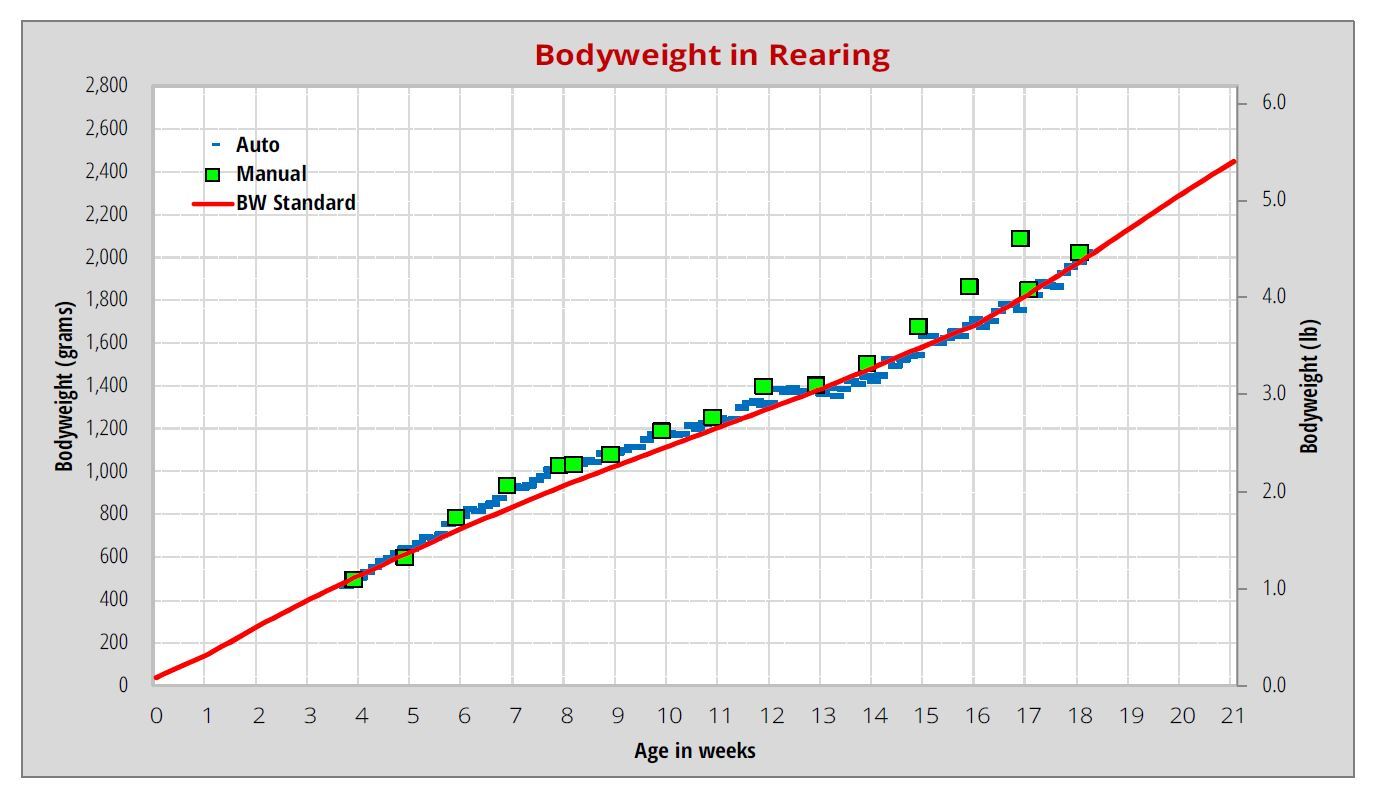
In the graph above, the daily, automatic weighing data (blue dots) consistently follow the weekly bodyweight standard. At 16 and 17 weeks of age, hand weighing (green dots) was done near the main feed hopper and the bodyweight increased compared with the fixed position of the auto scale. The differences in bodyweight were corrected when the hand weighing was done near the auto scale. This is a clear example how location changes in hand weighing can cause misguided average bodyweights that result in changes in the feeding program, potentially affecting conditioning of the females. This is particularly important for flocks between 16 and 20 weeks of age when a fixed development schedule is required to get the females in the right condition at 20 weeks of age.
Advantages of automatic scales:
- Daily weights available and graphically represented. Most modern house controllers have software for collection and analysis of bodyweight data.
- Many suppliers offer stand-alone computer systems which can collect data from up to 8 scales located among several houses.
- Ideal for houses without pens.
- Quick response to any deviations from the standard – indication of possible feeding equipment or distribution problems.
- Data is more consistent compared with hand weighing.
- Less labor – an advantage in terms of biosecurity and labor cost.
- If using pens, calculate weighted average uniformity.
Disadvantages of automatic scales:
- Not suitable for weighing males.
- Scale placement in production is important to prevent weighing a mix of male and female breeders. Scale placement on the slats will give a better representation of female weights.
- Less bird handling with automated scale systems can increase nervousness in a flock.
- Auto scales can be used until 30 to 35 weeks of age with good accuracy.
- After peak production heavier females tend to avoid scales.
- Will require personnel familiar with data collection, analyzing and computing technology.







